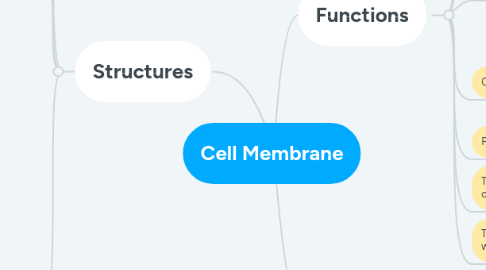
1. Structures
1.1. Phospholipid bilayer
1.1.1. Consists
1.1.1.1. Hydrophobic tails
1.1.1.1.1. nonpolar
1.1.1.1.2. 2 fatty acid tails linked to a glycerol backbone with phosphate group
1.1.1.1.3. saturation
1.1.1.2. Hydrophilic heads
1.1.1.2.1. polar
1.1.2. Amphipathic
1.1.3. Barrier for cell
1.1.4. Fluidity
1.1.4.1. Depends on
1.1.4.1.1. Temperature
1.1.4.1.2. Structure
1.1.4.1.3. Sterols
1.2. Glycolipid
1.3. Cholesterol
1.4. Proteins
1.4.1. Intercellular joinings
1.4.2. Enzymatic activity
1.4.2.1. respiration
1.4.2.2. photosynthesis
1.4.3. Transport
1.4.3.1. Types
1.4.3.1.1. Channel
1.4.3.1.2. Carrier
1.4.4. Cell-cell recognition
1.4.5. Anchorage/Attachment
1.4.6. Signal transduction
2. Functions
2.1. Physical connections between cells
2.1.1. Gap junctions
2.1.1.1. form channel between adjacent cells
2.1.2. Adhering cells
2.1.2.1. Desmosomes
2.1.2.1.1. anchor cells together
2.1.3. Tight junctions
2.1.3.1. seal cells together
2.2. Site of reactions
2.3. Communication between cells
2.3.1. Hormones
2.3.2. Nerve impulses
2.3.3. Receptors
2.4. Cell recognition
2.4.1. Carbohydrates
2.4.1.1. Glycolipids
2.4.1.2. Glycoproteins
2.5. Prevent entry of unwanted matter
2.6. Transport raw materials in and out of the cell
2.7. Transport manufactured products and wastes out of the cell
3. Fluid Mosaic Model
3.1. semi-permeable
3.2. not rigid rather flexible
3.3. asymmetrical
3.3.1. proteins move laterally through membrane
